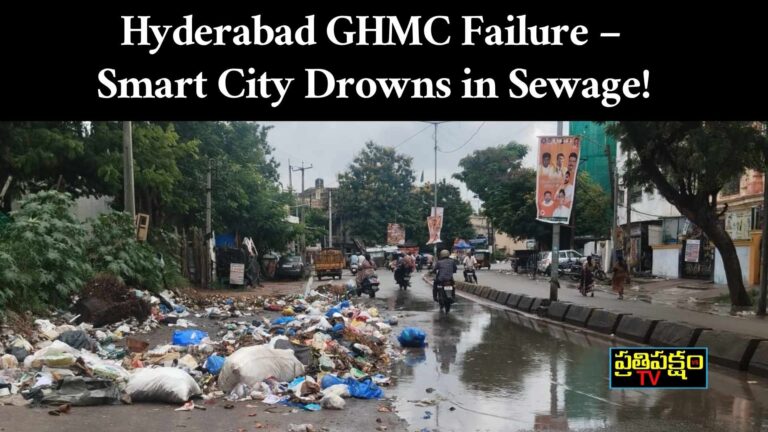Hyderabad GHMC Failure: Even a Light Rain Turns Roads into Sewage Streams
In Hyderabad, rain no longer brings joy — it brings fear and the stench of sewage.
Even a few minutes of rainfall turns city roads into ponds of filth. From Gudimalkapur to Karwan, Purana Pul, Asif Nagar, and Jiyaguda, streets are filled with garbage and drainage water. This is not a natural consequence of rainfall — it’s the direct result of GHMC’s (Greater Hyderabad Municipal Corporation’s) negligence.
Not Rainfall — It’s a Sewage Flow
On Wednesday evening, just a few minutes of rain was enough to paralyze life in several parts of the city.
Even an hour after the rain stopped, the water didn’t recede. Blocked drainage lines caused sewage to overflow onto the streets, mixing with garbage, plastic, and rotten vegetables. In areas like Gudimalkapur Market, Purana Pul junction, and Asif Nagar, residents and commuters suffered as the foul-smelling water remained stagnant for hours.
Voices of the People
Local vendors expressed their frustration —
“Sewage water is entering the market, and the stench makes it hard to breathe. GHMC officials come, take photos, and leave — but nothing changes,” said traders in Gudimalkapur.
Fruit sellers at Purana Pul said —
“Our shops are submerged in sewage water. We fear every rainfall.”
Residents of Asif Nagar echoed —
“Water is entering our houses. We can’t even take the garbage out. It’s the same problem every year.”
Smart City Dreams, Sewage Reality
The Telangana government boasts of a “Smart City” and “Digital Telangana.”
But citizens ask — “Before a Smart City, shouldn’t we have a Clean City?”
GHMC shows projects on paper but fails to deliver on the ground.
Flyovers are being built, but the drainage system remains outdated.
Even a short spell of rain turns roads into cesspools.
Every rainfall is a test of GHMC’s efficiency — and every time, they fail.
Ground Reality: Area-Wise Situation
Gudimalkapur Market:
Drainage water mixed with garbage and vegetable waste creates unbearable stench. Vendors work wearing masks to avoid the smell.
Karwan Junction:
Roads have turned slippery with mud and stagnant water. Two-wheelers skid frequently, causing traffic jams.
Purana Pul Bridge Area:
Sewage collects under the bridge, spreading foul smell. Garbage piles up along the roads as pedestrians struggle to walk through flooded lanes.
Asif Nagar Main Road:
Motorists drive through sewage-filled streets at risk. Garbage heaps line the roadside, and pedestrians find it nearly impossible to cross.
Jiyaguda Colonies:
Water stagnates in front of houses. Children play in dirty water, raising health concerns. Residents say they can’t even sit comfortably inside their homes because of the unbearable smell.
Public Health at Risk
This is not just an infrastructure problem — it’s a major public health threat.
When sewage mixes with garbage, diseases like cholera, typhoid, and dengue spread rapidly. After every rainfall, hospitals report a rise in fever and skin infections. GHMC’s failure is not just visible on roads — it’s evident in hospitals too.
Where Does the Budget Go?
Every year, GHMC allocates crores of rupees for stormwater drain maintenance.
Yet, citizens see no results.
Projects begin and “finish” on paper, but the ground reality remains unchanged.
This clearly exposes corruption and inefficiency within GHMC.
Political Apathy
During elections, every street is filled with posters, banners, and party flags.
But when roads are flooded with sewage, not a single leader shows up.
Local corporators and MLAs fail to respond to citizens’ concerns.
Even though Chief Minister Revanth Reddy’s government is new, GHMC’s performance remains the same — promises continue, but results don’t.
Where Is Accountability?
GHMC officials blame “old drainage lines.”
The Water Board says “there is no budget.”
Politicians blame “previous governments.”
But the public has one simple question —
“We pay taxes — but for what? To drown in sewage water?”
The Way Forward
1. Digital Drainage Mapping:
Real-time data must be available to identify flood-prone areas in every zone.
2. Zonal Monitoring Teams:
GHMC officers should be held accountable for their zone’s maintenance and cleanliness.
3. Public Feedback System:
Complaints should be resolved within 48 hours, with transparent tracking.
4. Redesign Old Drainage Lines:
Outdated systems must be replaced to match new constructions and roads.
5. Public Awareness:
Citizens must be educated not to dump waste into drainage systems.
Development Is Not Just Flyovers
Development doesn’t mean flyovers and malls alone.
True progress is reflected in clean streets and healthy living conditions.
When sewage flows beneath newly built flyovers, citizens see not progress but failure.
“Smart City” is just a slogan — what Hyderabad really needs is a Clean City.
Conclusion
From Gudimalkapur to Karwan, Purana Pul, Asif Nagar, and Jiyaguda —
a few minutes of rain expose the Hyderabad GHMC failure.
People are saying —
“We don’t want just a Smart City; we want a Clean City.”
The reflection of Hyderabad’s development today is in its sewage water —
and citizens now demand change, not in words, but in action.

